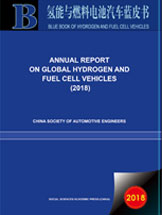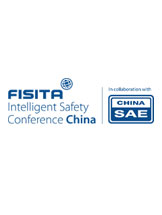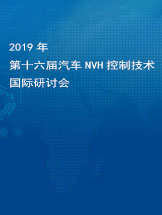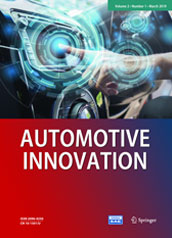

|
The journal Automotive Innovation is sponsored by China SAE, published through Springer, distributed around the world, and reflects the top-level research and technical advance of automotive engineering. Automotive Innovation newsletter in April includes the following contents: 1. A Glimpse of Experts——Prof. Yuyin Yan from University of Nottingham, UK 2. Article Recommendation——Five papers on technologies of lightweight, NVH and AMT Control method 3. China SAE News: · Annual Report on Global Hydrogen Fuel Cell Vehicle (2018) was published |

 Prof. Yuying Yan Chair in Thermofluids Engineering at University of Nottingham, UK; Director of HVACR and Heat Transfer for Low Carbon Automotive Engineering, Faculty of Engineering; Li Dak Sum Chair Professor and Director of Fluids Thermal Engineering Research Centre |
Research Interests and Expertise Heat transfer enhancement and efficient cooling for various industrial system and components, thermal management of low carbon vehicles, electric car battery thermal management, integrated cooling and optimization of electrified driving system, design and optimization of air-conditioning for conventional and new energy cars |
||
|
Achievements Prof. Yan has many years’ experiences in single phase and two-phase fluid flow and heat transfer. His research areas in heat transfer cover heat transfer enhancement, efficient cooling technology (microchannel boiling and condensation, heat pipes, and jet impingement, film cooling, pin-fin cooling), and elelctrohydrodynamic and electroosmotic driving effect on fluids & heat transfer. On electric car technology, he led his team developed high efficient extra-thin heat pipes and thermal management solutions for Li-battery systems, created integrated solutions for power electronics (IGBT) using high efficient vapour chamber, and explored with progress on e-motor spray cooling and integration of e-driving system thermal management. On low carbon vehicles research, he led his team has developed a leading technology thermoelectric generation of energy harvesting from engine exhausted gases, and the technology of heat pump air-conditioning for electric vehicles. He also carries out multidisciplinary research of biomimetics to tackle the issues of anti-frost and anti-icing of heat pump air conditioning. Prof. Yan’s researches are well sponsored by UK EPSRC, Royal Society, Royal Academy of Engineering, Innovate UK, APC and European Commission, as well as many industrial companies including Siemens, GKN, Dynex, FAW, Geely, etc. His recent 5 years research portfolio is about £7million. He is an elected Fellow and Deputy General Secretary of International Society of Bionic Engineering, UK Heat Transfer Committee member, and UK EPSRC Peer Review College. He was a member of EU ERC’s Advanced Research Grant Panel (2014-2017). He has supervised more than 36 PhD students and published more than 300 papers including 190 journal papers with over 4300 citations. He has chaired or co-chaired many international conferences/events, such as ICBE2010, ISHT2014, ICBE2016, ISHT&HPC2016, 3rdISFTE2017, and 16UKHTC2019. He is also China Ministry of Education awarded Changjiang Guest Chair Professor. |
|||
|
Perspective Thermal management has become crucial for the development of electric and other new energy vehicles and still faced many technical challenges in several aspects, such as dynamic responsive thermal management and integration of power batteries system, IGBT, and e-driving system; heat pumping type air-conditioning system for electric cars; etc. These have brought new challenges to not only thermal management engineers but also the heat transfer community. Indeed thermal management driven new energy/electric cars design has become very necessary and much work need to be carry out. |

   
|
Crashworthiness Optimization Design of Thin‑Walled Tube Filled with Re-entrant Triangles Honeycombs Fangwu Ma, Ying Zhao, Guowang Wang, Liang Wu, Yongfeng Pu |
||
| A novel re-entrant triangles-filled tube (RTT) is proposed through decoupling structural stiffness and energy absorption. Inner re-entrant triangles are employed to satisfy energy absorption, and outer thin wall is used to acquire high stiffness. This paper starts from establishment of theoretical models between geometric parameters of re-entrant triangles and relative density, equivalent elastic modulus and energy absorption characteristics, which are validated by experiments. On this basis, the optimal geometric parameters of unit cell are sought to maximize unit volume energy absorption and minimize relative density by adopting NSGA-II method. Subsequently, the cross-section of tube with optimal stiffness is obtained with targets for maximizing axial stiffness and lateral stiffness by employing static topology optimization method. To verify the proposed optimization method, RTT is analyzed and compared with positive Poisson’s ratio foam-filled tube (PFT), non-filled traditionally optimized tube (NTT) and pre-optimized square tube (PST). The results show that the novel RTT can improve stiffness and energy absorption performance simultaneously. Compared with the positive Poisson’s ratio material, re-entrant triangles honeycomb shows superior advantages in energy absorption. In comparison with the PFT, energy absorption of the RTT increases by 17.23%, and the peak crush force reduces by 5.04%. Therefore, the proposed decoupling design method demonstrates superiority in satisfying various performance requirements simultaneously. | |||
|
Keywords: Thin-walled tube · Re-entrant triangles honeycomb · Multi-objective optimization · Energy absorption · Structural stiffness Ma, F., Zhao, Y.,Wang, G., et al.: Crashworthiness Optimization Design of Thin-Walled Tube Filled with Re-entrant Triangles Honeycombs. Automotive Innovation 2(1), 1-13 (2019) |
|||
| Full Paper Reading>> | |||
   
|
Lightweight Body-in-White Design Driven by Optimization Technology Heguo Ou, Xiaodong Tang, Jieping Xiao, Yuanbo Wang, Zhongmin Ma |
||
| Structural optimization technologies are increasingly applied to lightweight automotive structural design. In a body-in-white (BIW) development project, optimization technologies are applied in three steps that are seamlessly integrated into engineering practice. By following a design driven approach, an innovative design that was 50.65 kg lighter than the base design was achieved. First, topology optimization was used to investigate the optimal material distribution in a given design space, and helped in extracting the main load path, while considering crashworthiness, NVH, and static stiffness performance requirements. In the second step, the effective design of a beam cross-section and feasible joints was carried out based on optimization technology and expert knowledge. In this step, the deep involvement of manufacturing process experts on stamping and joint connection feasibility analysis increased the chance of success remarkably. The sensitivity analysis, topography optimization, and gauge optimization of the created draft 3D BIW frame comprised the last step before finalizing the initial design. The new design was validated by full load case simulations, including full vehicle crashworthiness analysis, mode frequency and body mount point dynamic stiffness analysis, and BIW stiffness and component attachment stiffness analysis. The validation results indicate that the new BIW design achieves the performance goal, while being 13.3% lighter than the base design. | |||
|
Keywords: BIW design · Lightweight design · Structural optimization · Optimization technology Ou, H., Tang, X., Xiao, J., et al.: Lightweight Body-In-White Design Driven by Optimization Technology, Automotive Innovation 1(3), 255-262(2018) |
|||
| Full Paper Reading>> | |||
   
|
Simplified method of simulating double-layer micro-perforated panel structure Wan Chen · Chihua Lu · Zhien Liu · Songze Du |
||
| The micro-perforated panel (MPP) structure has been widely used in various noise control applications, and thus its acoustic performance prediction has been receiving increasing attention. The acoustic performance of simple MPP structures, such as a MPP sound absorber, has been predicted using an analytical calculation method. However, this is not a suitable approach toward predicting the acoustic performance of complicated MPP structures, owing to the structural complexity of these structures. Moreover, the many perforations of sub-millimeter scale diameter render the MPP structures very difficult to analyze using numerical simulation. Thus, this study focused on two different simplified MPP simulation methods: the transfer admittance method and the equivalent fluid method, and their application on double-layer MPP structures. Based on the two simplified MPP simulation methods, the transmission loss value of the double-layer MPP mufflers with two sets of different structural parameters was calculated, respectively. The predicted results were compared with the impedance tube measurements. The results revealed that the two simplified MPP simulation methods could effectively predict the acoustic performance of double-layer MPP structures. Moreover, the prediction based on the transfer admittance method can outperform the two simplified simulation methods. | |||
|
Keywords: Double-layer MPP structure · Acoustic simulation · Transfer admittance · Porous material · Experimental test Chen, W., Lu, C., Liu, Z., et al.: Simplified Method of Simulating Double-Layer Micro-Perforated Panel Structure. Automotive Innovation 1(4), 374-380(2018) |
|||
| Full Paper Reading>> | |||
   
|
Recycle-Friendly Aluminum Alloy Sheets for Automotive Applications Based on Hemming Hongzhou Lu, Junping Zhang, Ni Tian, Xinli Song, Mingtu Ma, Guimin Lu |
||
| Unavoidably, Fe impurities are mixed into Al alloys during recycling of aluminum automotive parts. High Fe content recycle-friendly aluminum alloy sheets (RASs) are discussed in terms of their applications to car body parts and closures. RASs have advantages, such as their low cost and light weight, they require less energy to process and they reduce emissions when used in vehicles. The hemming ability of RASs was investigated through various quenching rates and hot rolling reduction rates. The hemming factor (HF) values of low Fe-content samples (0.1 and 0.3 wt% Fe content) were 2 and 3. The hemming ability of samples with an Fe content of 0.5 wt% was unacceptable for applications to automotive outer closures (i.e., HF values of 4 and 5). The HF values changed from 3 to 5 for even higher Fe content samples (0.8 wt% Fe), depending on the quenching and hot rolling reduction rates. Lower quenching (air quenching) and lower hot-rolling reduction rates (6-pass hot rolling) both improved the hemming ability of the high Fe content samples. A low cost and recycle-friendly aluminum alloy automotive sheet from end-of-life vehicles is presented and its hemming properties are characterized. | |||
|
Keywords: Recycle-friendly · Lightweight · Hemming · Aluminum alloy · Automotive sheets · End-of-life vehicle Lu, H., Zhang, J., Tian, N., et al.: Recycle-Friendly Aluminum Alloy Sheets for Automotive Applications Based on Hemming, Automotive Innovation 1(1), 70-75(2018) |
|||
| Full Paper Reading>> | |||
   
|
MPC-Based Downshift Control of Automated Manual Transmissions Xin Li, Jidong Lyu, Jinlong Hong, Jinghua Zhao, Bingzhao Gao, Hong Chen |
||
| Automated manual transmissions, which usually adopt synchronizers to complete the gear shift process, have many advantageous features. However, the torque interruption and the challenging control objectives during the gear shift process limit its industrial application, especially for the power-on gear downshift. This paper proposes a model predictive control (MPC) method to control the clutch engagement process and effectively shorten the torque interruption, consequently enhancing the gear downshift quality. During the control law deduction, the proposed MPC also accounts for time-domain constraints explicitly. After the control law was deduced, it was validated through simulations under two typical power-on gear downshift working scenarios. Both of the simulation results demonstrate that the controller proposed in this paper can shorten the torque interruption time during power-on gear downshifts while minimizing vehicle jerk for overall satisfactory drivability. | |||
|
Keywords: Automated manual transmission · Gear downshift · Heavy-duty trucks · Clutch · Model predictive control Li, X., Lyu, J., Hong, J. et al. MPC-Based Downshift Control of Automated Manual Transmissions. Automotive Innovation 2(1): 55-63(2019) |
|||
| Full Paper Reading>> | |||

 |
|||
| Annual Report on Global Hydrogen Fuel Cell Vehicle (2018) was published | |||
|
China SAE jointly completed the Annual Report on Global Hydrogen Fuel Cell Vehicle with the United States Department of Energy, New Energy Industrial Technology Development Organization (NEDO) of Japan, Hydrogen Energy Promotion Agency of Korea (H2 Korea), and other several institutes, universities and companies. This book reviewed the current development status of the global hydrogen energy and fuel cell vehicle industry, and the research covered the development status of fuel cell vehicles, hydrogenation infrastructure and fuel cell systems, and also proposed policy advice for promoting the development of the hydrogen energy and fuel cell vehicle industry in China.
Fuel Cell Vehicle Department of China SAE: lyj@sae-china.org |
|||
 |
|||
| Automotive Innovation Editorial Board meeting was held successfully in Detroit | |||
|
Automotive Innovation Editorial Board meeting was held successfully on April 10th of 2019 at COBO Center, Detroit, USA. Twenty-one EB members and experts from North American and other regions participated in the meeting. Mr. Xuming Zhang, the Deputy Secretary-General of China SAE, gave an opening welcome speech. As the Executive Editor-in-Chief, Prof. Mike Ma has introduced the main work and achievements of the journal since its publication in 2018. Participated EB members and experts showed close attention, recognized the academic level of the journal and put forward many valuable suggestions in terms of the journal direction and main topics. They also discussed how to encourage innovation and how to enhance the journal’s international influence. Submission and Free Downloading: http://www.springer.com/42154 |
|||
 |
|||
| The inaugural FISITA Intelligent Safety Conference will be held in Beijing | |||
|
The inaugural FISITA Intelligent Safety Conference (I.S. C), Jointly organized by FISITA and China SAE, will be held on May 29, 2019 in Beijing (during CICV2019, the 6th International Congress of Intelligent and Connected Vehicles Technology).
This event will deliver a high-quality, international speaker line-up, which will consider and discuss the important topics of the safety of future mobility such as standards, regulation, design safety, test and evaluation, making this one of the important, must-attend events of 2019.
Some influential experts have been invited to participate, including Ms. Nadine Leclair (Renault CTO), Mr. Marc Pajon (senior expert of Renault), Dr. Jan-Erik Müller (VP of Complete Vehicle R&D China, BMW), Prof. Frank Zhao (President of FISITA ), Mr. Zhao Wang (Chief Engineer of Auto Standardization Research Institute), Mr. Ted Huang (CTO of Jiangling Motor) and Prof. Jian Wang(Jilin University), etc. It is the first time that FISITA has settled the technical exchange conference in China. Website: http://www.fisita.com/events/isc |
|||
 |
|||
| Preliminary agenda of CICV2019 has been released | |||
|
China SAE, Tsinghua University, China Intelligent and Connected Vehicles (Beijing) Research Institute Co. Ltd and Beijing Economic-Technological Development Area will jointly hold the "6th International Congress of Intelligent and Connected Vehicles Technology" (CICV2019) on May 29-31, 2019. The Congress will cover the fields of automobile, chips, AI, information and communications, transportation, etc. It is an information exchange platform for new technology display, industry integration and policy orientation. The preliminary agenda has been released.
Registration |
|||
 |
|||
| The 16th international symposium on Automotive NVH Control Technology (2019) will be held in Changzhou, China | |||
|
The 16th international symposium on Automotive NVH Control Technology (2019), hosted by China SAE and China Automotive Technology and Research Center Co. Ltd, will be held on May 29-30 in Changzhou, China. It is expected to attract more than 500 participants. By now, 15 symposiums have been held successfully from 2005 to 2018.
Preliminary Agenda |
|||

|
Automotive Innovation Automotive Innovation is the first English journal in China's automotive industry. Founded in 2018, sponsored by China SAE and published via Springer, Automotive Innovation has a very special significance in China's automotive academia. Since its inauguration, world-renowned automotive experts with high H index have been invited to join the editorial board, and the strict standards of SCI Journals are meticulously followed to ensure the high quality of papers and publication. By now, five issues have been published successfully with readers in 72 countries and regions. Many famous professors have already published articles in it, such as Prof. Liguang Li, Prof. Shijin Shuai, Prof. Ferit Küçükay, Prof. Xiangyang Xu, Prof. Amir Khajepour and so on. The journal has been recognized by FISITA, other international organizations and some well-known universities. Editors-in-Chief Jun Li, Academician of CAE, President of China SAE, Professor of Tsinghua University Frank Zhao, President (2018-2020) of FISITA, President of Tsinghua Automotive Strategy Research Institute Executive Editor-in-Chief Prof. Mike Ma,Executive Chief Editor of Automotive Innovation, Professor of Jilin University, VP Technical FISITA |
||||
|
Paper submission and browse www.ChinaSAEJournal.com.cn www.springer.com/42154 Contacts: Ms. Huisi, Gu Tel: +86-10-50950101 Email: ghs@sae-china.org |

|
|||
|
Sponsored |
Co-operated with
|
|||